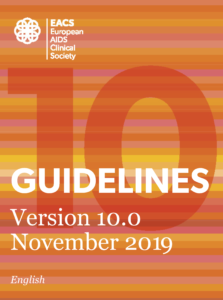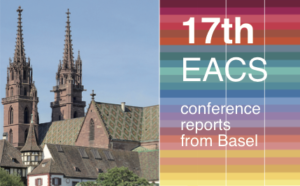EACS launch major update to European Treatment Guidelines (November 2019)
15 November 2019. Related: Conference reports, Guidelines, EACS 17 Basel 2019.
Every two years EACS publish a major update to their clinical guidelines, with minor revisions on alternate years. This is an international collaboration by over 60 leading European HIV doctors with additional input from experts in other fields.
 This year the major update includes many new sections, taking the print edition up to 260 pages, with additional information online including video links to EACS management lectures.
This year the major update includes many new sections, taking the print edition up to 260 pages, with additional information online including video links to EACS management lectures.
https://eacs.sanfordguide.com
The guidelines are also available on a free app for Apple and Android devices.
There are six main sections: a general section of all major issues, recommendations for ART, drug-drug interactions, co-morbidities, hepatitis coinfection and opportunistic diseases.
In addition to the most widely applied sections, for example, on preferred drugs for first-line ART, or for managing virological rebound, there are new reference sections for use in specific populations. This edition includes new tables for managing drug interactions for transgender people, for older people and for those with reduced kidney function.
The guidelines are therefore developed as reference resource to cover the broad diversity of adults living with HIV – with different ages, genders and complex treatment histories.
The whole guidelines have been updated to include new ARVs with notes for different combinations and patient circumstances and removal of older drugs (including older PIs, ddI and d4T).
Other selected changes to this edition are listed below.
A full list of changes at this link:
https://eacs.sanfordguide.com/contents/changes-v9-1-to-v10-0
Nine short webcasts (3-5 minutes each) with each panel chair talking through the changes are online at this link:
http://resourcelibrary.eacs.cyim.com/mediatheque/media.aspx?mediaId=78087&playlistId=78091&channel=28172
Translations into Chinese, French, German, Japanese, Portuguese, Russian and Spanish are currently being updated and will be available for the new edition shortly.
ART
- New recommendation preferring unboosted integrase inhibitors (INSTI) with high genetic barrier (dolutegravir or bictegravir) as third drug for first-line ART.
- Doravirine + 2 NRTIs included in recommended regimens.
- When indicated, TDF/3TC has been added as a backbone.
- Dual therapy with dolutegravir (DTG) + lamivudine (3TC) has been upgraded to recommended regimen.
- High genetic barrier INSTI or boosted PI is recommended for initial therapy if results from resistance testing are not available.
- Switch strategies for virologically suppressed persons include DTG + 3TC has been included in dual therapies supported by large clinical trials and darunavir/b + rilpivirine has been included as dual therapy option supported by small trials.
- Whole section related to pregnancy and conception has been updated with treatment guidance regarding different scenarios.
- ART in TB/HIV co-infection updated for new drug interactions.
- Drugs for use in PEP has been expanded to include recently approved drugs.
- F/TAF is included as alternative for PrEP in MSM and transgender women.
Drug interactions
- All tables have been updated for bictegravir and doravirine and removal of older ARVs.
- Hormone therapy and gender transitioning.
- Dose adjustments for non-HIV meds and kidney function.
- Drugs classes to avoid in older people.
Comorbidities
This section included the greatest number of changes and new additions, covering a wide range of complications, many linked to lifestyle differences and changes.
- These included use of e-cigarettes, closer cardiovascular monitoring (based on 10% rather than 20% risk), blood pressure and hypertension, renal monitoring and liver monitoring etc.
- Sexual health changes include new statement on U=U, conception and screening for menopause.
- The section on depression, include the impact on overall well-being.
- The cognitive guidelines include either CSF resistance testing or on likely ART toxicity for modification of ART.
- Viral hepatitis coinfection
Reorganised into general management, HBV and HCV with updates for:
- Recommendations for screening for HCC.
- Diagnosing fibrosis.
- HBV reactivation.
- Retreatment after failure with DAAs.
- Preferred and alternative DAA combinations.
- Management of acute HCV.
- Management of hepatitis D and E (HDV and HEV).
Opportunistic infections (OIs)
- Updated information of timing of ART with different OIs
- New table on clinical presentation of IRIS.
- Updated information on treatment of CMV, HSV, VZV, histoplasmosis and cryptococcosis.
- New information on treatment for talaromycosis.
- Details on management of MDR-TB have been added to the TB section as well as a table detailing doses for all TB drugs.
Simon Collins is a community representative on the comorbidities panel for these guidelines.
comment
These guidelines are an essential reference for the minimum standards of care that HIV positive people can use with their doctors.
They set a goal for optimum standards of care for activists when national guidelines, for example, still use older and less effective treatments.
They also provide up-to-date guidelines for many settings when national guidelines for whatever reason are either difficult to produce or update.
Reference
European AIDS Clinical Society (EACS). Guidelines version 10.0, November 2019.
https://www.eacsociety.org/guidelines/eacs-guidelines/eacs-guidelines.html


 Simon Collins, HIV i-Base
Simon Collins, HIV i-Base